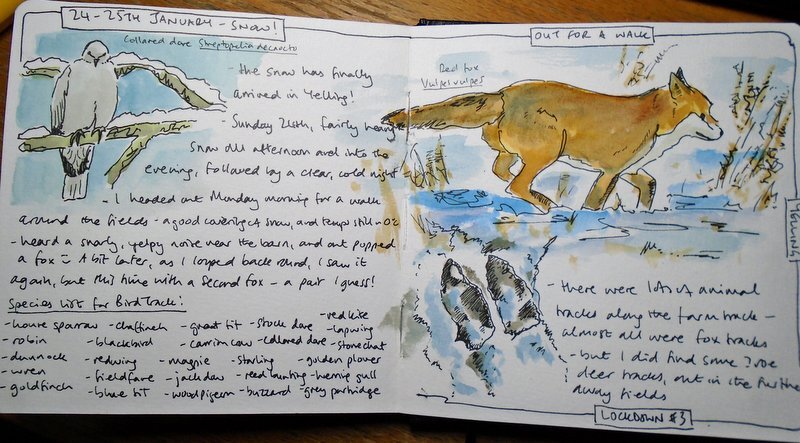Edith Holden’s Country Diary of an Edwardian Lady is an iconic publication. Edith kept the diary for a year, in 1906, and with beautiful illustrations and writing recorded the countryside she found around her, both at home and on her travels. She included not only drawings and paintings, but also poetry, proverbs and sayings, and important dates and festivals, along with dated written entries describing the weather, her observations of the natural world, and background information about many of the plants, birds, insects and animals that she saw.
Edith didn’t write the diary for publication; it remained in her husband’s family, and was eventually published in 1977, some 57 years after her death. I was a small child when the book was published, but I remember how popular it was – everyone seemed to have a copy! I loved looking at the pictures, and it no doubt inspired my early forays into drawing and into nature.
So, when I found myself re-inspired by nature journalling some decades later, I bought a second-hand copy of the Country Diary of an Edwardian Lady and settled down for a read – and got a bit of a surprise! In one of the early entries, on January 18th, Edith describes ‘a curious oak tree, growing in a field near Elmdon Park’. Elmdon Park? That sounds familiar! I hadn’t realised that when she kept the diary, Edith had been living very close to where I grew up in Solihull and south Birmingham, UK. I read on, finding references to other familiar places – St Bernard’s Road, Widney Lane, Packwood Hall, Olton, Bentley Heath, Knowle, Baddesley Clinton, Catherine de Barnes, Bickenhill…
Often Edith describes (and paints) the plants she finds on her wanderings around Warwickshire, writing lists associated with places. It’s a fantastic snapshot of what was there. One observation really caught my eye: ‘Along a lane just above Balsall, I came suddenly upon a great flock of Meadow Brown butterflies. I had seen numbers of them all along the way, but here the air was thick with them flying hither and thither…’ (July 21st). I honestly cannot imagine finding Meadow Browns (or any other butterfly) in such huge numbers, in the Warwickshire countryside, today. It brings home what we have lost, what we never even knew.
The time-capsule quality of the Country Diary of an Edwardian Lady got me thinking about my own nature journalling. I live in a rural corner of Cambridgeshire, but the threat of development is ever present. There’s not much space in these small islands, and change will almost certainly come. A lot of my journalling is based on what I see and hear when I’m out walking or running, so is tied to a place and time, although I’m certainly not as thorough as Edith was in surveying, especially plants! But still, it’s a snapshot of an afternoon, or a trip out somewhere, and I try to be descriptive both in drawing and writing about what I’ve seen. Journalling about the everyday natural world, the things we see on our daily journeys, or even just looking out of the window, provides a rich – and highly personal – source of information, a window onto our particular world, that will surely fascinate in the years ahead.
Edith’s Warwickshire patch is still rural in nature, but things have, of course, changed immensely since 1906. Farming methods have changed. Roads have been built, lots of them. There’s now an international airport on her doorstep – the very first airplane ever flew in 1903, only three years before Edith kept her diary. There are some areas that she would still recognise, but the sheer amount of road-building and infrastructure has greatly altered the landscape. It’s hard to imagine how much has changed, how much has been lost, but Edith Holden’s Country Diary of an Edwardian Lady is a time-capsule – an eye-witness account of her everyday natural world.
And mine and yours can be too. In the shadow of the pandemic there is appetite for change in how we interact with nature, how we live our lives. Will it happen? Can we change our trajectory? Maybe in the decades to come our families will be able to look at the changing world we lived in, through the everyday observations in our journals – that alone makes it a meaningful and exciting project!
About the Author
I live in a small village in Cambridgeshire, UK, happily surrounded by fields and nature. I especially enjoy drawing and sketching inspired by the natural world, and am looking forward to resuming leading nature journal sessions with my local Wildlife Trust.
Instagram: @sharoncambs
Facebook: SharonsPics




